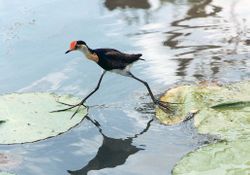- Comb-crested Jacana
-
Comb-crested Jacana 
Comb-crested Jacana (Irediparra gallinacea) Conservation status Scientific classification Kingdom: Animalia Phylum: Chordata Class: Aves Order: Charadriiformes Family: Jacanidae Genus: Irediparra
Mathews, 1911Species: I. gallinacea Binomial name Irediparra gallinacea
(Temminck, 1828)The Comb-crested Jacana (Irediparra gallinacea), also known as the Lotusbird or Lilytrotter, is the only species of jacana in the genus Irediparra. Like other jacana species, it is adapted to the floating vegetation of tropical freshwater wetlands.
Jacana is Linnæus' pseudo-Latin misspelling for the Brazilian Portuguese Jaçanã (from a Tupi name of the same bird) whose pronunciation is approximately [ža.sa.náN].
Contents
Description
This species is unmistakable. It has a black crown and hindneck with a fleshy red wattle covering the forehead and forecrown, contrasting with a white face and throat. There is a broad black band on the lower breast with white belly. Underwing black. Back and upperwing mainly grey-brown with black primary coverts, rump and tail. Long legs with extremely long toes. The male is slightly smaller than the female and measures 20–22 cm (7.9–8.7 in) in length and weighs 68–84 g (2.4–3.0 oz). The female measures 24–27 cm (9.4–11 in) in length and weighs 120–150 g (4.2–5.3 oz).[1] The wingspan ranges from 39 to 46 cm (15 to 18 in).
Distribution and habitat
It occurs in southeastern Borneo, the southern Philippines, Sulawesi, Moluccas, Lesser Sunda Islands, New Guinea, New Britain, and northern and eastern Australia. Its habitat is freshwater wetlands with abundant floating vegetation, such as water-lilies or water hyacinth, forming a mat on the water surface.
Food
It eats seeds and aquatic insects gleaned from floating vegetation or the water surface.
Voice
This species gives a squeaky, high-pitched chittering.
Breeding
The Comb-crested Jacana is polyandrous. It builds a flimsy nest on floating or emergent vegetation, in which the female lays four lustrous, pale brown eggs covered by black markings. Only males incubate. The young hatch well-developed and soon leave the nest.
References
- ^ CRC Handbook of Avian Body Masses by John B. Dunning Jr. (Editor). CRC Press (1992), ISBN 978-0849342585.
- BirdLife International. (2006). Species factsheet: Irediparra gallinacea. Downloaded from http://www.birdlife.org on 10 February 2007
- Marchant, S.; Higgins, P.J.; & Davies, J.N. (eds). (1994). Handbook of Australian, New Zealand and Antarctic Birds. Volume 2: Raptors to Lapwings. Oxford University Press: Melbourne. ISBN 0-19-553069-1
- National Photographic Index of Australian Wildlife. (1987). The Shorebirds of Australia. Angus & Robertson: Sydney. ISBN 0-207-15348-5
]

This Charadriiformes-related article is a stub. You can help Wikipedia by expanding it.

